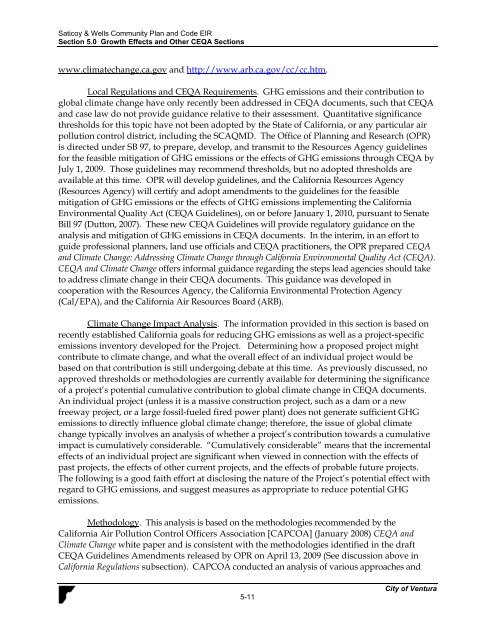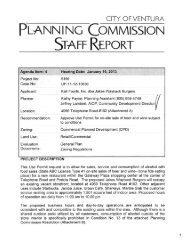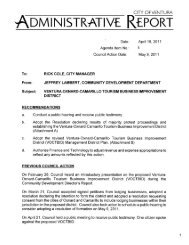Saticoy & Wells Community Plan & Development ... - City Of Ventura
Saticoy & Wells Community Plan & Development ... - City Of Ventura
Saticoy & Wells Community Plan & Development ... - City Of Ventura
You also want an ePaper? Increase the reach of your titles
YUMPU automatically turns print PDFs into web optimized ePapers that Google loves.
<strong>Saticoy</strong> & <strong>Wells</strong> <strong>Community</strong> <strong>Plan</strong> and Code EIRSection 5.0 Growth Effects and Other CEQA Sectionswww.climatechange.ca.gov and http://www.arb.ca.gov/cc/cc.htm.Local Regulations and CEQA Requirements. GHG emissions and their contribution toglobal climate change have only recently been addressed in CEQA documents, such that CEQAand case law do not provide guidance relative to their assessment. Quantitative significancethresholds for this topic have not been adopted by the State of California, or any particular airpollution control district, including the SCAQMD. The <strong>Of</strong>fice of <strong>Plan</strong>ning and Research (OPR)is directed under SB 97, to prepare, develop, and transmit to the Resources Agency guidelinesfor the feasible mitigation of GHG emissions or the effects of GHG emissions through CEQA byJuly 1, 2009. Those guidelines may recommend thresholds, but no adopted thresholds areavailable at this time. OPR will develop guidelines, and the California Resources Agency(Resources Agency) will certify and adopt amendments to the guidelines for the feasiblemitigation of GHG emissions or the effects of GHG emissions implementing the CaliforniaEnvironmental Quality Act (CEQA Guidelines), on or before January 1, 2010, pursuant to SenateBill 97 (Dutton, 2007). These new CEQA Guidelines will provide regulatory guidance on theanalysis and mitigation of GHG emissions in CEQA documents. In the interim, in an effort toguide professional planners, land use officials and CEQA practitioners, the OPR prepared CEQAand Climate Change: Addressing Climate Change through California Environmental Quality Act (CEQA).CEQA and Climate Change offers informal guidance regarding the steps lead agencies should taketo address climate change in their CEQA documents. This guidance was developed incooperation with the Resources Agency, the California Environmental Protection Agency(Cal/EPA), and the California Air Resources Board (ARB).Climate Change Impact Analysis. The information provided in this section is based onrecently established California goals for reducing GHG emissions as well as a project-specificemissions inventory developed for the Project. Determining how a proposed project mightcontribute to climate change, and what the overall effect of an individual project would bebased on that contribution is still undergoing debate at this time. As previously discussed, noapproved thresholds or methodologies are currently available for determining the significanceof a project’s potential cumulative contribution to global climate change in CEQA documents.An individual project (unless it is a massive construction project, such as a dam or a newfreeway project, or a large fossil-fueled fired power plant) does not generate sufficient GHGemissions to directly influence global climate change; therefore, the issue of global climatechange typically involves an analysis of whether a project’s contribution towards a cumulativeimpact is cumulatively considerable. “Cumulatively considerable” means that the incrementaleffects of an individual project are significant when viewed in connection with the effects ofpast projects, the effects of other current projects, and the effects of probable future projects.The following is a good faith effort at disclosing the nature of the Project’s potential effect withregard to GHG emissions, and suggest measures as appropriate to reduce potential GHGemissions.Methodology. This analysis is based on the methodologies recommended by theCalifornia Air Pollution Control <strong>Of</strong>ficers Association [CAPCOA] (January 2008) CEQA andClimate Change white paper and is consistent with the methodologies identified in the draftCEQA Guidelines Amendments released by OPR on April 13, 2009 (See discussion above inCalifornia Regulations subsection). CAPCOA conducted an analysis of various approaches and5-11<strong>City</strong> of <strong>Ventura</strong>
















